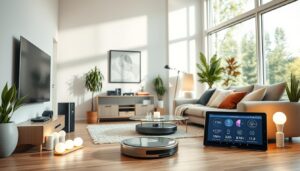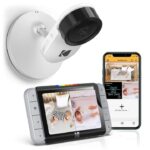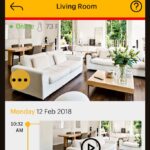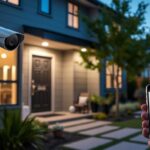Technology keeps getting better, making our homes smarter. In 2024, it’s easier than ever to make your home smart. You can get devices that make life easier, save energy, and keep you safe.
At the heart of a smart home are devices that connect to the internet. You can control them with apps or just your voice. This includes things like smart speakers, cameras, and lights. It all works together to make your home just right for you.
Contents
- 1 Smart Home Technology Fundamentals
- 2 Smart Home Basics: Core Devices for Beginners
- 3 Smart Security Solutions for Modern Homes
- 4 Home Environment Control and Energy Management
- 5 FAQ:
- 5.1 What are the essential components of a smart home?
- 5.2 What are the different connection types used in smart homes?
- 5.3 How do voice assistants work in smart homes?
- 5.4 What are the core smart home devices for beginners?
- 5.5 What smart security solutions are available for modern homes?
- 5.6 How do smart thermostats and energy-efficient devices contribute to home environment control and energy management?
Smart Home Technology Fundamentals
The modern smart home uses many connected devices. These devices talk to each other using wireless signals. This makes our homes more comfortable, convenient, and efficient.
What Makes a Home “Smart”?
A smart home has many devices. These include security systems, lights, and entertainment. They all work together through a central hub or app.
These devices can talk to each other and to us. This lets us control our home easily, by voice or remotely.
Different Connection Types: WiFi, Bluetooth, and Z-Wave
Smart devices use different ways to connect. WiFi is common and fast. It’s great for devices that need to send lots of data.
Bluetooth and Z-Wave are good for devices that use less power. They work over long distances, which is useful for sensors.
The Role of Voice Assistants
Voice assistants like Alexa and Google Assistant are key in smart homes. They let us control our home with just our voice. This makes our homes easier to use.
| Wireless Protocol | Typical Use Cases | Advantages | Disadvantages |
|---|---|---|---|
| WiFi | Streaming, high-bandwidth devices | Widespread compatibility, high speed | Higher power consumption, potential congestion in dense environments |
| Bluetooth | Low-power sensors, wearables | Energy-efficient, long-range connectivity | Limited data transfer speeds, shorter range compared to WiFi |
| Z-Wave | Security systems, home automation | Robust, long-range, low-power communication | Proprietary protocol, limited device compatibility |

“Smart home technology empowers users to control various aspects of their home remotely and automate functions using Internet-connected devices.”
Smart Home Basics: Core Devices for Beginners
Building a smart home starts with a few key devices. These devices help you automate and control your space. Let’s look at some must-have gadgets for beginners.
Smart Speakers: The Voice Control Hub
Start with smart speakers like Amazon Echo or Google Nest. They let you control your home with voice commands. You can play music, control smart lights, and smart thermostats with just your voice.
Smart Plugs: Transforming Traditional Appliances
Smart plugs are a great first choice. They make regular appliances into smart plugs you can control. Use them to turn on lamps, fans, or coffee makers with your voice or app.
Smart Lighting: Customizable and Convenient
Smart lighting is a popular choice. It lets you change brightness and colors. You can also set lights to turn on and off automatically, saving energy.
Smart Thermostats: Optimizing Energy Usage
Smart thermostats like Ecobee or Nest help with temperature and energy. They learn your habits and adjust the temperature for you. This saves money on heating and cooling.
Start with smart speakers, plugs, lighting, and thermostats. These devices create a connected and convenient home. Begin with these basics and grow your smart home over time.

Smart Security Solutions for Modern Homes
Smart home tech is changing fast. Security is key for homes to feel safe and worry-free. Today’s homes use smart devices to keep threats away.
Video Doorbells and Surveillance Cameras
Video doorbells, like Ring, let you see and talk to visitors from afar. They work with phones for quick action on any odd activity. Smart cameras, like Arlo Pro 3, give clear video and see in the dark, covering the outside well.
Smart Locks and Access Control
Smart locks mean no more keys. The Ultraloq U-Bolt Pro lets you open doors with voice, fingerprints, or phone. They make homes safer and easier to manage, letting you control who comes in.
Security Systems and Sensors
Systems like SimpliSafe or ADT use many sensors and cameras for full protection. They send alerts, let you watch live, and work with other smart stuff. New tech, like Matter, makes devices work better together.
Smart homes are getting safer with new tech. Using smart cameras, locks, and systems, homes are well-protected. Homeowners can relax, knowing their homes are safe inside and out.
Home Environment Control and Energy Management
Smart thermostats like the Ecobee Smart Thermostat with Voice Control manage your home’s climate. They learn what you like and use less energy. You can control them from anywhere and connect them with other smart devices.
Smart power strips and energy monitoring plugs help save energy. They track how much energy you use. Automated blinds and smart fans also help keep your home at the right temperature.
These smart devices work together to make your home comfortable. They might even save you money on energy and help the planet.
Energy-efficient smart devices save energy and help the planet. They only work when needed. This makes your home more efficient and convenient.
Smart home technology lets you control things with your voice. This makes managing your home’s energy easier.
The global market for Home Environment Control and Energy Management is growing fast. It’s expected to hit $182,442 million by 2025. People are spending a lot on smart home gadgets, over $200 billion by 2027.
Adding smart home devices can increase your home’s value. It makes your home worth more than similar ones nearby.
FAQ:
What are the essential components of a smart home?
A smart home has smart speakers, security cameras, and video doorbells. It also has thermostats and lighting. These devices connect to WiFi and can be controlled with apps or voice assistants. This makes life easier, saves energy, and keeps homes safe.
What are the different connection types used in smart homes?
Smart homes use WiFi a lot. They also use Bluetooth, Z-Wave, and Zigbee. Some homes have cellular or landline backups for extra reliability.
How do voice assistants work in smart homes?
Voice assistants like Alexa and Google Assistant help control devices with just your voice. They work with IFTTT for more device integration. This makes controlling your home easy and hands-free.
What are the core smart home devices for beginners?
Beginners should start with smart speakers, smart plugs, and smart light bulbs. Smart thermostats are also key. These devices make your home smart and save energy.
What smart security solutions are available for modern homes?
Modern homes can use video doorbells, smart cameras, and smart locks. These devices send alerts and let you watch your home from anywhere. They make your home safer.
How do smart thermostats and energy-efficient devices contribute to home environment control and energy management?
Smart thermostats like Ecobee learn your habits to save energy. Smart plugs and blinds help control energy use. Together, they make your home comfy and can save money and the planet.



